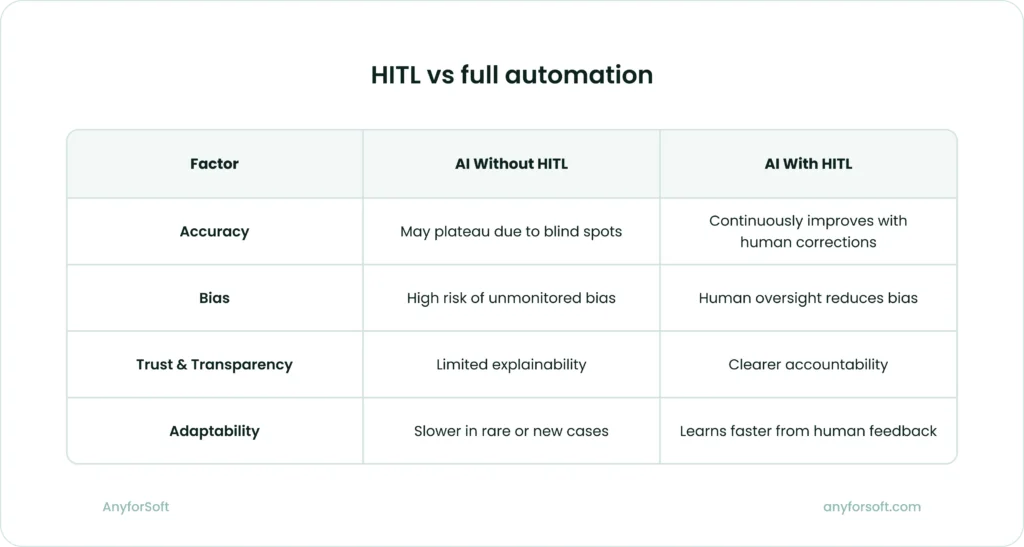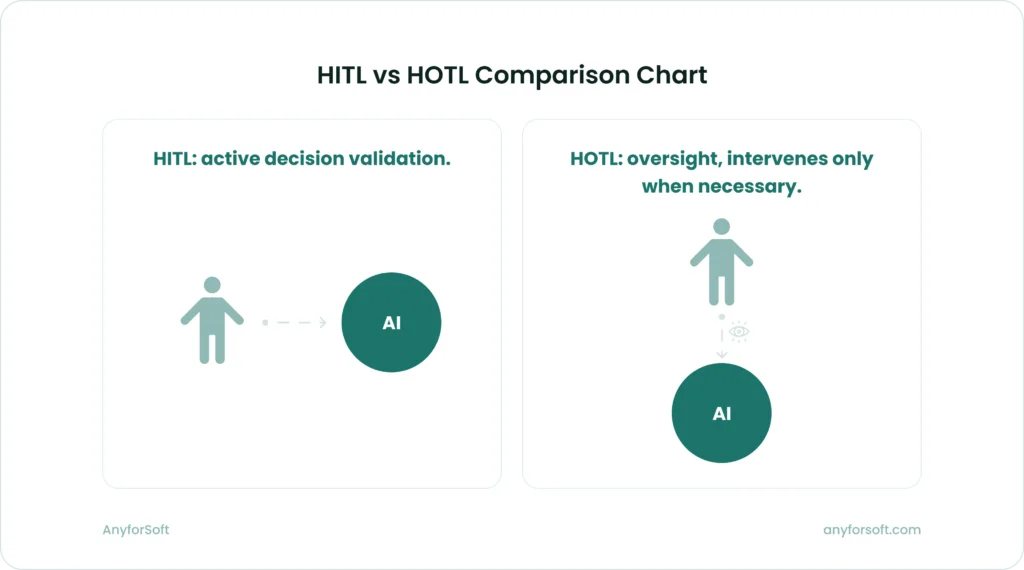Artificial intelligence has changed the way businesses operate, learn, and innovate. But while machines are great at processing vast amounts of data, they’re not perfect. The question many companies ask is: How do we make AI accurate, ethical, and trustworthy for mission-critical use?
The answer often lies in a concept called human in the loop (HITL).
In this article, we’ll break down the human in the loop meaning, explain how it differs from other approaches, show where it’s applied in practice, and how businesses can benefit from human in the loop systems. Whether you’re evaluating AI adoption or refining your digital strategy, understanding HITL meaning and specifics is key.
Curious how AI human-in-the-loop methods can strengthen your processes? AnyforSoft’s AI expertise is unmatched. Explore our numerous cases and reach out to us for a free consultation to find the perfect AI solution for you.
What Is Human in the Loop (HITL) Meaning?
At its core, human in the loop means a design approach where humans are part of the AI decision-making process. Instead of leaving machines to act independently, people review, validate, and guide AI outputs.
This isn’t about slowing down innovation; it’s about making sure technology works as intended.
Breaking Down the Term
- The loop: The continuous feedback cycle between machine and human.
- The human: An expert, moderator, or operator validating or correcting AI results.
- The goal: Improve system accuracy, fairness, and adaptability.
For example, a machine learning model that tags online images may misclassify unusual or ambiguous visuals. A human in the loop steps in, corrects the mistake, and that correction feeds back into the AI model — making it smarter over time.

Full automation means the machine makes decisions independently with minimal human input. In contrast, the human in the loop approach ensures that humans monitor or intervene when outputs are uncertain, sensitive, or high-stakes.
This is key because AI, even at its most advanced stage, still struggles with nuance. HITL ensures humans in the loop complement machine speed with judgment.
Why Human-in-the-Loop Matters for AI and Machine Learning
AI promises speed and scale, but without human oversight, it risks being biased, opaque, or even harmful. That’s why HITL is at the heart of human in the loop AI meaning in practical applications.
Improving AI model training
HITL speeds up model refinement. Humans validate edge cases, identify errors, and supply better training data. This continuous loop improves model performance faster than automation alone.
Balancing efficiency and ethics
AI can mirror the biases in the data it’s trained on. Human intervention reduces those risks by spotting unfair patterns and ensuring ethical results.
Keeping humans in charge
Trustworthy AI means transparency. With HITL, humans aren’t replaced but are accountable for the final outcome — essential in regulated industries like healthcare, finance, and education.
Human in the Loop vs. Human on the Loop
You may also hear the phrase human on the loop. While similar, the two approaches serve different purposes.
- Human in the loop (HITL): Humans actively review AI decisions before action is taken. Example: A doctor validating an AI-generated diagnosis.
- Human on the loop (HOTL): Humans supervise AI at a higher level, intervening only when outputs deviate from expected norms. Example: A pilot monitoring autopilot.
Key difference
- HITL = proactive involvement.
- HOTL = oversight and intervention.
Both human on the loop vs human in the loop approaches matter. HITL is critical where accuracy is key, while HOTL is for high-volume, low-risk operations that only occasionally need human input.
Want more practical insights? Read our breakdown of LMS vs LCMS: Key Differences to see how decision frameworks shape technology adoption.

Real-World Applications of Human-in-the-Loop AI
The human-in-the-loop systems approach is already impacting industries where accuracy, ethics, and adaptability matter.
Healthcare: doctors + AI for safer diagnoses
AI tools can analyze scans and lab results at scale, but physicians review edge cases and validate results before treatment. HITL prevents life-threatening errors.
Content moderation: humans catch what AI misses
AI filters millions of posts daily, but when context matters — satire, cultural nuance, or sensitive topics — humans step in to prevent over-filtering or harmful oversights.
Autonomous vehicles: human intervention for safety
Even the most advanced self-driving cars rely on human takeover in unexpected scenarios like unusual traffic or weather conditions.
Education: teachers guiding AI-driven learning
In digital learning platforms, AI may suggest personalized lesson paths. Teachers act as the human in the loop, validating recommendations and ensuring they align with student needs.
As we mentioned earlier, AnyforSoft has extensive experience in the AI field. So, if you are interested in learning more about AI in education, we have shared our observations on the main pros and cons of this topic that you may find interesting.
Challenges and Best Practices in the Human-in-the-Loop Approach
Like any approach, HITL is not without challenges. Knowing the pitfalls helps businesses design smarter systems.
Challenges
- Cost: Adding humans increases operational expenses compared to full automation.
- Latency: HITL systems may be slower if human checks are required at scale.
- Human fatigue: Humans themselves can make mistakes under pressure or volume.
Best practices
- Set thresholds for human intervention. Don’t involve humans in every decision; only in critical or uncertain cases.
- Invest in training. The quality of HITL depends on how well humans understand their role in the loop.
- Automate selectively. Use AI for repetitive, low-risk tasks and HITL for high-value or sensitive ones.
Pro tip: The future isn’t about AI or humans. It’s about orchestrating the loop so both work together.
FAQs About AI Human in the Loop
AI without HITL relies solely on automation, while HITL integrates human validation to reduce errors and bias.
Not always. HITL is most valuable in high-stakes fields like healthcare, finance, and security, but less critical for low-risk automation.
By correcting edge cases and providing better training data, HITL accelerates model refinement and adaptability.
It can, but selective intervention ensures efficiency without sacrificing accuracy.
Conclusion – Finding the Right Balance
So, what is human in the loop meaning in practical terms? It’s the balance point between AI’s speed and human judgment’s nuance. HITL ensures machines not only work but work responsibly.
As businesses adopt AI, HITL will play a growing role in:
- Building trust with users.
- Reducing bias and error.
- Ensuring compliance with evolving regulations.
- Delivering transparent, explainable AI outcomes.
Your next step is not deciding whether AI should involve humans — it’s deciding where and how much human oversight is needed.
At AnyforSoft, we help companies design and implement AI solutions that align with the best practices and fully meet their needs. Contact our team today to discuss how AI-powered approaches can work for your business.








